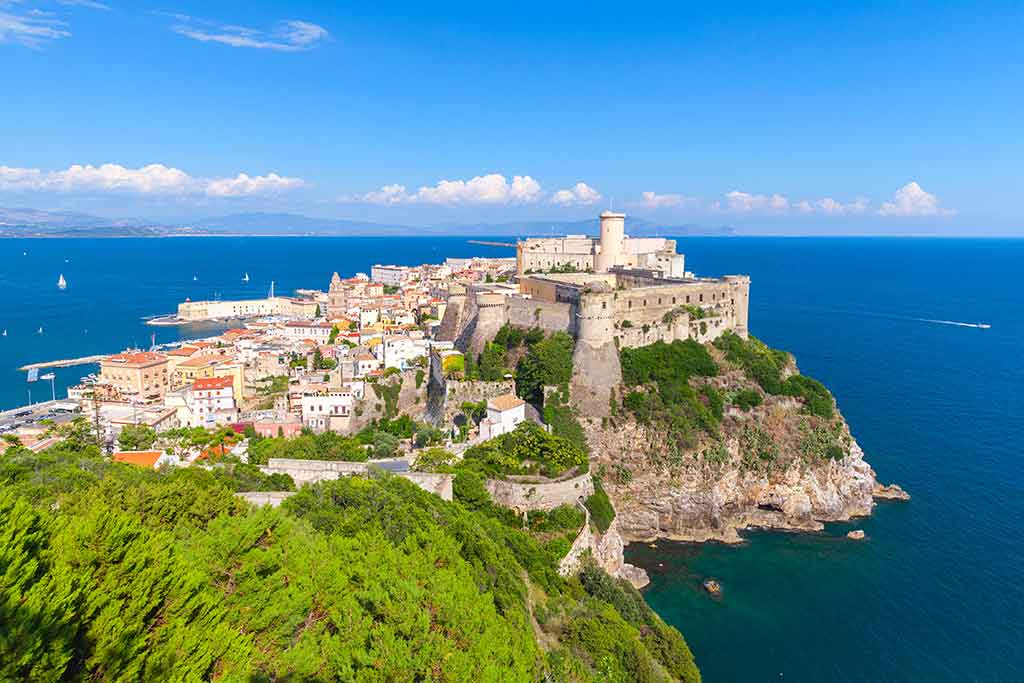
Gaeta, the village with the Catello in the foreground
Gaeta is a renowned resort since the times of the ancient Roman Empire. It is Virgil himself in the Aeneid who derives the name of the town from the nurse of Aeneas, Caieta, who would have found burial on these shores.
Thanks to its favourable position and mild climate, it was a territory of medieval urban settlements of which traces still remain today. The natural landscapes, from the sea to the headlands, preserve works of art from different eras that allow visitors to alternate peaceful days at the sea in its various beaches to visit places of great cultural interest.
Gaeta beaches spread over a gulf that in different eras had strategic importance from a commercial and military point of view. For years it has been one of the most important seaside resorts on the Tyrrhenian coast, for services aimed at the most varied utilities. On the west coast there are a series of beaches, known for their fine and golden sand, surrounded by green hills that fall overlooking the crystal clear sea.
The most popular beach, Serapo, is located in the heart of the urban center, between the promontory of Monte Orlando that houses the sanctuary of Madonna Spaccata and the area of Fontania. The beach of Serapo is the most equipped in the town, thanks to the offer of numerous services and the possibility of access to different free spaces, in addition to the presence of the park in front of the destination of children who can play in the shade in the hottest afternoon hours.
Immediately follows the small beach of Fontania (partly free, partly equipped), which can be accessed from an ancient staircase and a descent modern. The name of the small beach comes from the Roman villa built in this place by the Roman consul Gneo Fonteio, villa of which it is still possible to admire the ruins. Particularly fascinating is the landscape of this cove, literally immersed in greenery and surrounded by the so-called caves of Fontania, consisting of rooms with roofing barrel.
Proceeding north, the landscape changes and with it the coast: follow one another the beaches of the Arenauta, and the wide beach of Sant'Agostino, in large part free.
Art immersed in nature From the extreme area of the beach of Serapo stands Monte Orlando, on the top of which, in a panoramic position, is finds the mausoleum of Lucio Munazio Planco, a Roman personality who at the time of Caesar founded the colonies of Lyon and Basel. The mausoleum and the promontory are home, especially in the summer, of events that recall the ancient Roman origins. Near the top there is the sanctuary dedicated to the Trinity, with the suggestive Montagna Spaccata, called so because, according to tradition religious, on Good Friday night an earthquake would have split the mountain into three points. Many tourists access it to visit above all one of the slits called the Turco Grotto, which opens, deep and dark, in the deep blue sea, creating games of light and showing the splitting of the rock.
You can admire other monuments and places of particular artistic interest on the extreme tip to the east, in which the medieval district developed, a place of walks through the tangled alleys, cloisters, churches, the capanile and the cathedral. The most characteristic and well-known alley is that of Via dell'Indipendenza, where characteristic shops and small markets are hidden and you can taste a product typical of the area, the famous Gaetana tiella, once a poor dish of peasants and fishermen, today the pride of the cuisine of the area, in its variants with vegetables or with polyps.
Many works of art where you can come across during a walk in the historic center date back to the twelfth century, such as the majestic bell tower of the Duomo , the cathedral, the Church of San Giovanni a Mare and the castle (built from the 13th to the 16th century). Still outside the walls of the old city, visible from the street for its imposing appearance and placed on a small hill, is the church of San Francesco (19th century), which It is accessed by a vast staircase, showing the colorful and mottled panorama of the port and the gulf.
Sport, music and leisure
In Gaeta many sports are linked to the sea, and recently the beach of Serapo offers services capable of involving the more varied utilities, from beach volleyball courts to water aerobics. Of course, the site of Monte Orlando, today a nature park with views overlooking the sea, has a freeclimbing path (for climbing it is good to remember also the rocks that give on the beach of Sant'Agostino), itineraries for mountain biking and equipment scattered throughout the park for joggers.
The town has in some nerve points, especially near the municipal building, cycle paths that allow adults and children to enjoy the city by crossing the center and the area called della Pignasecca, with a vast avenue bordered by plane trees. Along this artery in the evening life comes alive thanks to the different tourist facilities, the carousels for the little ones and the puppet theater, an ancient tradition that does not cease to fascinate the tourists and the Gaetans themselves, who often like to spend their evenings here.
Towards the seafront of Serapo, the beaches and the municipality offer dancing evenings, cultural events and musical concerts of the most diverse genres, in the name of the fun and conviviality.
This guide has been translated automatically through a third party service. Visititaly offers these automatic translations to help site visitors, however the automatic translations may contain inaccuracies, errors or inaccuracies. You can contact us to report inaccuracies or errors and we will check the translation.